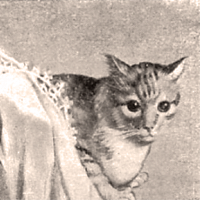The Humanitarian Society was based in Loria's home and would become one of the most important institutions in Milan. Programs for education and training for employment were carried out and in 1906 and 1909 separate locations were set up for encouraging the skills relating to the Arts and Crafts resulting in 1905 in an embroidery program taught by Adele Sottili (under the name Adele Sottili Calori, she would later publish at least one book: L'arte nei lavori femminili. Cifre monogrammi per ricamo. [Art in feminine works. Monogram Ciphers for Embroidery] - I can find one copy at the Libreria Naturalistica in Bologna if you have a spare 180 euros!) Eugenia Volpi is listed in the Society's archives as an assistant in the festival section of embroidery, 1906-07; Elisa Cantoni is listed as an assistant for courses of design and embroidery in 1915 but I can't find any other information on them.
In 1919 the Humanitarian Society participated in the Esposizione Regionale Lombardia d'Arte Decorativa [Lombardy Regional Exposition for the Decorative Arts] and in the catalogue for the expo there is this needlework:

In a 1916 issue of Emporium (Vol. XLIII, n. 254) I found an article by Alfredo Melani with lots of photos of the needlework produced by the Humanitarian Society.
The designs reflect the period and there are many techniques employed, sometimes all on one piece!




The Emporium article talks of courses in the women's section on embroidering household and personal linens (white on white) and on "luxury" embroideries (using coloured threads), on tailoring and even one on ironing!
The Humanitarian Society was bombarded in 1943-44 and many of the sections including the women's sections were completely destroyed. The courses on sewing and embroidery were not back up and running until 1947. However, the times were changing and by 1965, traditional domestic activities for women were passé and courses in needlework were no longer viable. The Humanitarian Society still runs today with programs in Decorative Arts though I could find no evidence that needlework was among them. Check out their website for lots of information (in Italian).
Special thanks to Claudio from the Ning group MI1906 who brought this bit of Milan's history to my attention and kindly donated the scan from the catalogue!





Connecting across the miles...I teach ESL at the Humanitarian Society, and always have been moved by the founder's ideals: to give a helping hand to the illiterate and unskilled peasants streaming into Milan to work for him and for other industrialists, so that--with the help of their own elbow grease--they could improve their lives and the lives of their families. Not a hand-out, but a helping hand. It still seems a better recipe for success than many programs currently in place. Now, the Society caters not just to career-oriented self-improvement, but also to fun-oriented self-improvement, which particularly helps the elderly to stay and feel young, to remain socially connected, another important goal. At least a few years ago, there were embroidery lessons. It depends not on the school's plans, but on what the all volunteer teachers offer. Thanks for this post, I'll send a link to the office. I know they will be happy and proud.
ReplyDeleteThanks Star for the update on the Società, perhaps we can look for some historical photos on your blog?
ReplyDelete;-))
Now I know why your English is so good!
Dear Jeanine, happy to oblige! Go to: http://mymilanitaly.blogspot.com/2010/10/counting-my-blessings-01.html
ReplyDeleteAnother excellent insight into yet another Italian craft based society that is new to me. Thanks very much for the article and I look forward to yet more revelations.
ReplyDeleteHow interesting is the Umanitaria story and what a wonderful broderies they could do. I seldom saw some like these.
ReplyDeleteDaniela